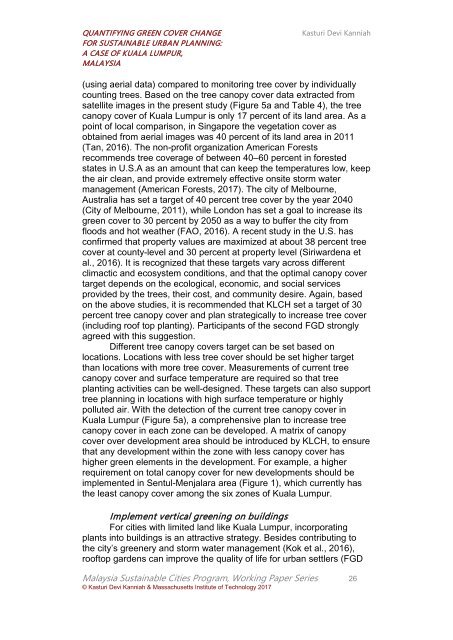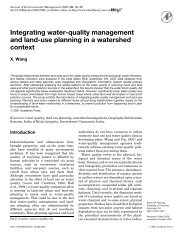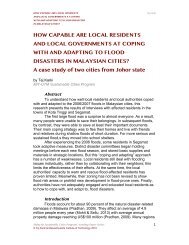Kanniah
You also want an ePaper? Increase the reach of your titles
YUMPU automatically turns print PDFs into web optimized ePapers that Google loves.
QUANTIFYING GREEN COVER CHANGE<br />
FOR SUSTAINABLE URBAN PLANNING:<br />
A CASE OF KUALA LUMPUR,<br />
MALAYSIA<br />
Kasturi Devi <strong>Kanniah</strong><br />
(using aerial data) compared to monitoring tree cover by individually<br />
counting trees. Based on the tree canopy cover data extracted from<br />
satellite images in the present study (Figure 5a and Table 4), the tree<br />
canopy cover of Kuala Lumpur is only 17 percent of its land area. As a<br />
point of local comparison, in Singapore the vegetation cover as<br />
obtained from aerial images was 40 percent of its land area in 2011<br />
(Tan, 2016). The non-profit organization American Forests<br />
recommends tree coverage of between 40–60 percent in forested<br />
states in U.S.A as an amount that can keep the temperatures low, keep<br />
the air clean, and provide extremely effective onsite storm water<br />
management (American Forests, 2017). The city of Melbourne,<br />
Australia has set a target of 40 percent tree cover by the year 2040<br />
(City of Melbourne, 2011), while London has set a goal to increase its<br />
green cover to 30 percent by 2050 as a way to buffer the city from<br />
floods and hot weather (FAO, 2016). A recent study in the U.S. has<br />
confirmed that property values are maximized at about 38 percent tree<br />
cover at county-level and 30 percent at property level (Siriwardena et<br />
al., 2016). It is recognized that these targets vary across different<br />
climactic and ecosystem conditions, and that the optimal canopy cover<br />
target depends on the ecological, economic, and social services<br />
provided by the trees, their cost, and community desire. Again, based<br />
on the above studies, it is recommended that KLCH set a target of 30<br />
percent tree canopy cover and plan strategically to increase tree cover<br />
(including roof top planting). Participants of the second FGD strongly<br />
agreed with this suggestion.<br />
Different tree canopy covers target can be set based on<br />
locations. Locations with less tree cover should be set higher target<br />
than locations with more tree cover. Measurements of current tree<br />
canopy cover and surface temperature are required so that tree<br />
planting activities can be well-designed. These targets can also support<br />
tree planning in locations with high surface temperature or highly<br />
polluted air. With the detection of the current tree canopy cover in<br />
Kuala Lumpur (Figure 5a), a comprehensive plan to increase tree<br />
canopy cover in each zone can be developed. A matrix of canopy<br />
cover over development area should be introduced by KLCH, to ensure<br />
that any development within the zone with less canopy cover has<br />
higher green elements in the development. For example, a higher<br />
requirement on total canopy cover for new developments should be<br />
implemented in Sentul-Menjalara area (Figure 1), which currently has<br />
the least canopy cover among the six zones of Kuala Lumpur.<br />
Implement vertical greening on buildings<br />
For cities with limited land like Kuala Lumpur, incorporating<br />
plants into buildings is an attractive strategy. Besides contributing to<br />
the city’s greenery and storm water management (Kok et al., 2016),<br />
rooftop gardens can improve the quality of life for urban settlers (FGD<br />
Malaysia Sustainable Cities Program, Working Paper Series 26<br />
© Kasturi Devi <strong>Kanniah</strong> & Massachusetts Institute of Technology 2017






